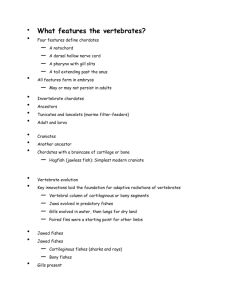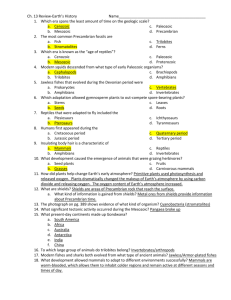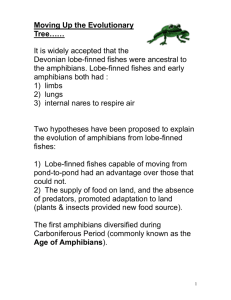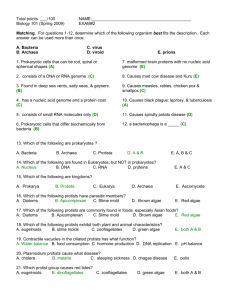Phylum Chordata From Sea Otters to Sea Squirts
advertisement
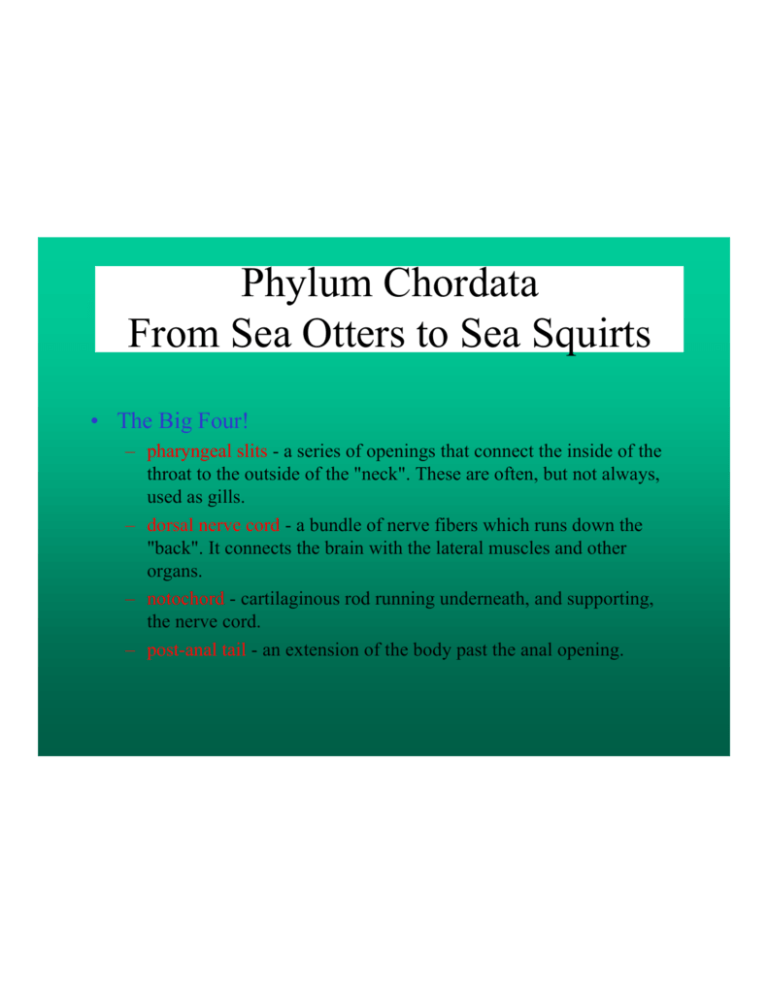
Phylum Chordata From Sea Otters to Sea Squirts • The Big Four! – pharyngeal slits - a series of openings that connect the inside of the throat to the outside of the "neck". These are often, but not always, used as gills. – dorsal nerve cord - a bundle of nerve fibers which runs down the "back". It connects the brain with the lateral muscles and other organs. – notochord - cartilaginous rod running underneath, and supporting, the nerve cord. – post-anal tail - an extension of the body past the anal opening. Chrodate Body Plan The basic chordate body plan consists of a tube within a tube. The inner "tube" is the digestive tract and the outer "tube" is the body wall. The cavity space between the two tubes is the coelom. Note that the coelom is lined with mesoderm. The major chordate characteristics, notochord and dorsal nerve cord (shown here as the neural tube), are also part of the body plan. Evolutionary Linkages The evolutionary relationship between the echinoderms and hemichordates (acorn worms) is indicated by the similarity of their larvae. Both larval forms are small, motile, and swim by utilizing bands of cilia. Weirdos from the Burgess Shale Some Designs Failed Chordate Phylogeny Chordate Characteristics • The Big Four! – Bilateral symmetry; segmented body; three germ layers; welldeveloped coelom. – Notochord (a skeletal rod) present at some stage in life cycle. – Single, dorsal, tubular nerve cord; anterior end of cord usually enlarged to form brain. – Pharyngeal gill slits present at some stage in life cycle. • Other Characteristics: – Postanal tail, usually projecting beyond the anus at some stage but may or may not persist. – Segmented muscles in an unsegmented trunk. – Ventral heart, with dorsal and ventral blood vessels; closed blood system. – Complete digestive system. – A cartilaginous or bony endoskeleton present in the majority of members (vertebrates). Chordate Subphyla The Burgess Shale Chordate Radiation Subphylum Urochordata •- The swimming larvae resemble tadpoles and possess all of the four key chordate characteristics. •"Tail Cord." There are approximately 1500 described species of these marine living chordates. They are commonly called tunicates (also sea squirts) because of the tough, nonliving tunic that surrounds the animal. As sessile adults they lose the notochord and the tail, their dorsal hollow nerve cord becomes reduced, but they retain the pharyngeal gill slits. Example: tunicates, sea squirts Urochordate Characteristics Colonial Tunicates Subphylum Cephalochordata "Head Cord" • There are only 25 species described in this subphylum of marine lancelets. – They are all small, slender, laterally compressed, translucent animals. – Textbook example of the four key chordate characteristics. Once considered to be the ancestor of the chordates, they are still believed to more closely resemble the earliest prevertebrates than any other animal known. – Examples: Amphioxus (the lancelets) A Typical Cephalochordate Body Plan The Lowly Chordate on the Seafloor--Who would have guessed? Subphylum Vertebrata Subphylum Vertebrata "Backboned" • This is the largest and most diverse subphylum of chordates whose evolution has been guided by the basic adaptations of: – – – – the living endoskeleton efficient respiration advanced nervous system paired limbs This group is divided into those without jaws and those with jawed mouths. Superclasses and Classes of Subphylum Vertebrata •Superclass Agnatha ("Without jaws"): Those vertebrates without true jaws or appendages including the hagfishes and the lampreys. •Superclass Gnathostomata ("Jawed mouth"): Those vertebrates with jaws and usually with paired appendages. -Class Chondrichthyes - The cartilaginous fishes. -Class Osteichthyes - The bony fishes. -Class Amphibia - The amphibians. -Class Reptilia - The reptiles. -Class Aves - The birds. -Class Mammalia - The mammals. Superclass Agnatha • Characteristics: – – – – – – – – Slender, eel-like body. Median fins but no paired appendages. Fibrous and cartilaginous skeleton; notochord throughout life. Heart with one atrium and one ventricle. Dorsal nerve cord with differentiated brain. Digestive systems without stomach. Sense organs of taste, smell and hearing. External fertilization. • Examples of living “Agnaths”: – Class Myxini - The hagfishes – Class Cephalaspidomorphi - The lampreys Sea Lampreys Gross!!! Fossil Agnaths The first vertebrates to evolve were the agnathans. Their traces are found in rocks of the Late Cambrian period, more than 520 million years old. These first fishes had no jaws in which to seize and manipulate prey. Nor did they have paired fins, to stabilize their bodies in the water. The bony armor has been preserved in the rocks, and gives the fossil agnathans their collective name of ostracoderms, meaning "shell-skins."Despite their lack of jaws, ostracoderms dominated the seas and freshwaters of the northern hemisphere for about 130 million years, from Early Ordovician to Late Devonian times. Silurian Predators-Eurypterids Major Evolutionary Step #1 • The Evolution of Jaws--Why is this so important? Jaw Evolution 1) ancestral fishes were jawless and somewhat similar to today's agnathans 2) anterior gill arches began to be modified into jawlike structures 3) functional jaws were first exhibited in the Placodermi 4) shows the configuration of jaws in most modern fishes Placoderms The placoderms, or "flat-plated skins," were a strange assemblage of heavily armored jawed fishes. Several large, interlocking plates formed a bony head shield, while another series of plates encased the front part of the body in a trunk shield. The rest of the body was usually naked, with no scaly covering. This group was the first to exhibit jaws, which exhibited broad dental plates instead of teeth. They first appeared in the Early Devonian and had died out by the Early Carboniferous. Huge Jawed Predators These fish are common in Silurian Rocks in Ohio Class Chondrichthyes Members have a cartilaginous skeleton, pectoral fins and pelvic fins, probably evolved in the sea from ancestors of Placoderms during the Devonian or earlier. •These possess a lateral line system. •By lacking the armor of their ancestors, this group exhibits a greater degree of mobility. •Also, the appendages' bone types are featured in the tetrapod vertebrates. Extant representatives are sharks and rays. Major Characteristics of Class Chondrichthyes: • Characteristics: – – – – – – A heterocercal caudal fin. Mouth ventral. Skin with placoid scales. Endoskeleton entirely cartilaginous. Placoid Scales! Two-chambered heart. Respiration by means of 5 to 7 pairs of gills with separate and exposed gill slits, no operculum. – No swim bladder or lung. – Internal fertilization and separate sexes. • Examples – Sharks, Skates and Rays – Chimaera or ratfish Cartilaginous Body Plans Cartilaginous Wonders •Agnatha- jawless, armored protovertebrates without paired appendages •Placodermi- jawed armored extinct fishes with paired appendages •Chondrichthyes- cartilaginous fishes •Osteichthyes- bony fishes with an operculum and swim bladder. This group diversified into lung- ray- and lobe-finned fishes, the latter of which gave rise to the amphibians. Class Osteichthyes The "bony fishes" evolved in freshwater, apparently diverging from an ancestor common to placoderms and chondrichthyes about 425 or 450 MYA. In members of this group, calcium phosphate reinforces the skeleton. Other characteristics of bony fishes include: • mucus production • a very well developed lateral line system, a swim bladder (which evolved from lung-like sacs derived from the pharynx and used for respiration in many early bony fishes) and an operculum. Both bony and cartilaginous fishes diversified extensively in the Devonian and Carboniferous, leading to ray-finned fishes, lobe-finned fishes, and lungfishes. Lobe-finned fishes (similar to the coelocanth) gave rise to amphibians. Ray-Finned Fishes Interestingly, although the ray-finned fishes include the modern fishes and are the most diverse group of vertebrates, they are a "dead-end" in terms of evolution, since there are no "more advanced" groups which evolved from them. Lobe-Finned Fish Although among the fishes the lobe-finned fishes were not as successful as the ray finned fishes, they proved to be in the mainstream of evolution because they gave rise to the other groups of vertebrates. One of the members of the lobefinned group provided the ancestor of the first land animals, the amphibians. This transition was accomplished relatively quickly in their evolution; the first lobe-finned fishes appeared in the Early Devonian, and by the end of that period, some 20 million years later, the amphibians had set foot on dry land. A Living Colecanth Lungfish Paleontologists agree that the amphibians must have evolved from one of the 3 groups of lobe-finned fishes (lungfish, coelacanths, or extinct rhipidistians). However, there is disagreement on which group is the most likely ancestor. Most paleontologists consider that amphibians evolved from the rhipidistian fishes, based on the remarkable similarity in the pattern of bones in their skulls and fins/limbs. Other paleontologists, however, believe that the lungfish were ancestral to the amphibians, since the development of the lungs, nostrils and limbs of living lungfish is strikingly similar to those of living amphibians. Major Evolutionary Step #2 • The Move to Land Why Make that First Step???? Class Amphibia Age of Amphibians This figure illustrates the similarities in bone structure between the lobe-finned fishes (such as coelacanths) and amphibians. The muscles and bony axis of the paired fleshy fins of these fishes provide a structure that could easily have evolved into the limbs of an early amphibian. Similarly, there seems little doubt that these fishes possessed lungs like those of amphibians. Living lungfish, for example, have them, and a similar structure (though single) is present in the living coelacanths. That First Step! What Makes an Amphibian an Amphibian ? Ichthyostega-That First Step!! Fossils of the earliest amphibian, Ichthyostega, were found in Greenland and were dated about 370 MYA when Greenland was part of a Euramerican continent that lay near the equator, and stretched from today's western North America to eastern Europe. Members of this genus are most often considered to represent the type of animal which first exhibited a terrestrial existence, unlike its ancestors, the lobe finned fishes. Pangaea Revisited A remarkable feature of the distribution of these early amphibians, and of their relatives, the reptiles, is that until the middle of the Permian period (about 100 million years later), nearly every one of them has been found only on this former Euramerican continent. This strongly suggests that this continent was the homebase in which they first evolved and diversified. Only after the middle of the Permian--when Asia and the southernlandmass of Gondwana had become attached to Euramerica to form the supercontinent of Pangaea--did the amphibians and reptiles spread throughout the world. Implications for Biodiversity Major Step#3-The Amniotic Egg The most important modifications which enabled subsequent vertebrates to become independent of the aquatic environment were 1) modifications of the outer covering into a multilayered skin which is fairly impermeable to water and 2) evolution of an amniote egg. The evolution of this type of egg was a major step in the conquest of the terrestrial environment. Probably, it was first exhibited in stem reptiles. What Makes a Reptile a Reptile?? Reptilian Evolution Class Reptilia includes 7,000 species of lizards, snakes, turtles and crocodilians. They exhibit important characteristics for terrestrial life (keratinized scales, lungs, amniote egg, et al.). Ectothermy allows them to survive using only 10% of the energy expended by mammals of similar size. Reptiles first arose during the Carboniferous, about 300 MYA. Class Reptilia Stem Reptiles From among their members came 2 major evolutionary lines--one led to the mammals, and the other to the archosaurs, "ruling reptiles". Plesiosaurs Plesiosaurs were large marine reptiles of the Mesozoic. They exhibited long narrow flippers which aided locomotion of their sturdy, deep bodies and short tails. There were two major groups (or superfamilies) of plesiosaurians, which differed in the lengths of their necks and in their feeding habits. The plesiosaurs had long necks and short heads, and fed on smaller sea creatures. The pliosaurs had short necks and large heads to enable them to bite and swallow larger prey. Ichthyosaurs The Ichthyosaurs, “fish lizards” flourished throughout the Jurassic Period and into the Cretaceous. They had a streamlined, torpedo-shaped body with a stabilizing dorsal fin on the back; short, paired paddles for steering; and a strong, fishlike tail with 2 equal lobes for swimming. Ball-and-socket joints between the tail vertebrae allowed for powerful strokes from side to side. The tail, together with the great flexibility of the backbone, propelled the animal rapidly through the water- the swimming method used by modern, fast-moving fishes. Synapsids Therapsids (reptilian ancestors of the mammals) and the mammals themselves all exhibit a skull like that of the synapsids. It has an opening behind each eye socket which allowed the development of longer jaw muscles. This resulted in stronger jaws that could be opened wide and closed forcefully, to deal with large prey. Therapsids Therapsids were descended from the stem reptiles and are presumed to be the ancestors of the mammals. "Non-reptilian" characteristics of members of this group were thoracic and pelvic skeletal features which permitted the legs to be positioned directly underneath the body. The Evolution of Birds Archaeopteryx is considered by many to be a "missing link" because it exhibits both reptilian and avian characteristics. It dates from the Jurassic, about 150 MYA. It had teeth and a long pointed tail (like reptiles but unlike birds), but also had feathers and skeletal elements (like birds but unlike reptiles). South American Phororhachids-35 MYA Flightless, fast-running predatory birds, some nearly three meters tall, armed with enormous beaks and claws. These birds were the dominant South American land carnivores for much of the Cenozoic; recently, phororhachid bones have been found in Florida, suggesting that phororhachids were not confined to South America. Class Mammalia Mammals evolved from reptilian stock (therapsids) before birds. Fossils 220 MY old have been found which are believed to be those of early mammals. Mammal descendents coexisted with dinosaurs during the Mesozoic. Early mammals were small shrew-like organisms which are presumed to have been insectivorous nocturnal forms. Most agree that the extinction of dinosaurs opened adaptive zones which could subsequently be taken over by mammals. The Cenozoic, 63 MYA to present is sometimes called the Age of Mammals. Class Mammalia What Makes a Mammal a Mammal? Mammalian Characteristics • • • • • • • • • Hair composed of keratin; endothermy; 4 chambered heart; diaphragm; mammary glands produce a nutritionally balanced product, milk, to nourish neonates; most are born rather than hatched (eggs are fertilized internally and in placentals, embryos develop in utero many have large brains and are capable learners; long duration of parental care; dentition specialization. Extinctions Led the Way! Explosive Adaptive Radiation Mammal Phylogeny South American Mammals The Great Faunal Exchange! Primate Taxonomy New World and Old World Monkeys Two distinct modern groups of monkeys exist, the "new world monkeys" and "old world monkeys". Ancestors of these groups existed around 40 million years ago in Africa and/or Asia. How did new world monkeys got to South America? New world monkeys (including spider monkeys, capuchins, and squirrel monkeys) are all: •Arboreal •have prehensile tails •Have nostrils which open to the side. Old World Monkeys Old world monkeys include monkeys (mandrills, baboons, macaques and rhesus monkeys) and apes (chimpanzees, gorillas, orangutans, and gibbons). •Both are arboreal and ground dwelling forms among old world monkeys •None have prehensile tails. •Their nostrils open downward. Humans & Ape Distinctions In searching for fossil relatives of humans, we need to be aware of the differences between men and apes. These fall into three functional categories that have evolved separately from one another: • • • Cranial differences Dental differences Locomotion differences Cranial Differences • By comparison to apes, humans have: – Larger brains (1200 cc vs. 500 cc) • The larger brain creates a number of differences in other cranial features: – – – – flatter face smaller brow ridges no post-orbital constriction no sagittal crest Skull Shapes Ape Human Dentition • By comparison to apes, humans have: – – – – – – smaller canines no gap between upper canine and premolar no sectorial (modified) first lower premolar relatively small incisors and large molars very thick molar enamel a parabolic rather than U-shaped dental arch Dentition Apes Human Hominid Radiation & Climate Hominid Phylogeny 1-5 MYA The Cradle of Humanity Hominid Adaptive Radiation WHY? Locomotion • By comparison to apes, humans have: – a foramen magnum that points down – a curved lumbar spine – a short, flared (versus long and thin) ilium (the upper most section of the hip bone or pelvis) – a strong, robust talus (ankle bone) – a strong, non-opposable big toe – a complex two-way arch system in the foot Pelvis Structure Hominid Foot Prints Hominoid Taxonomy Vertebrate Diversity Over Time
